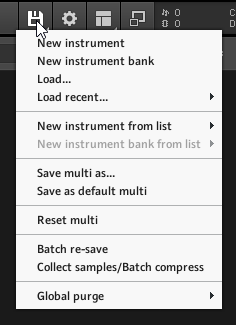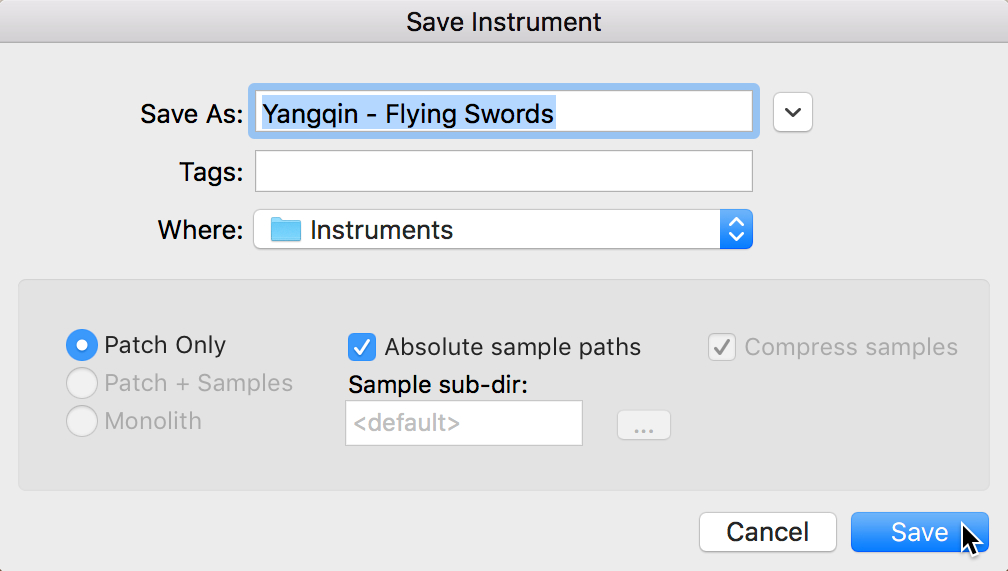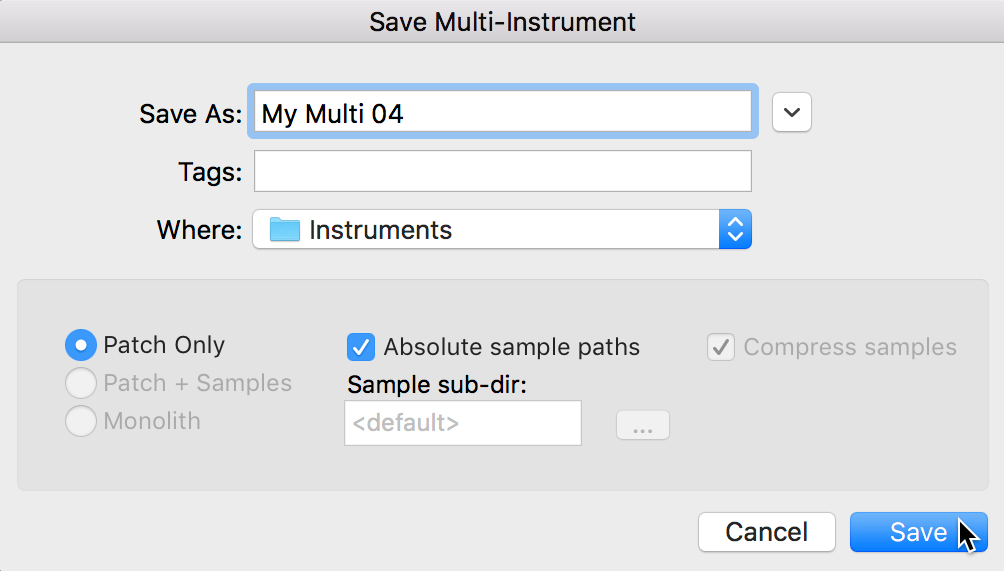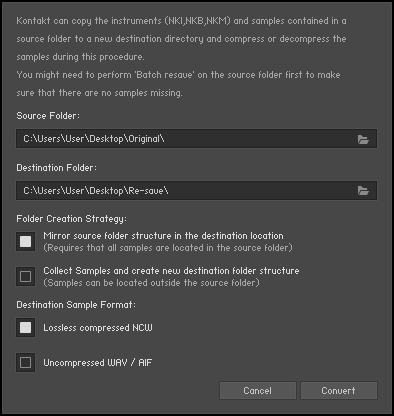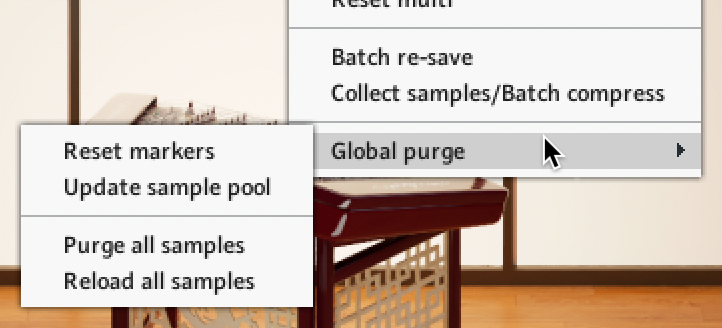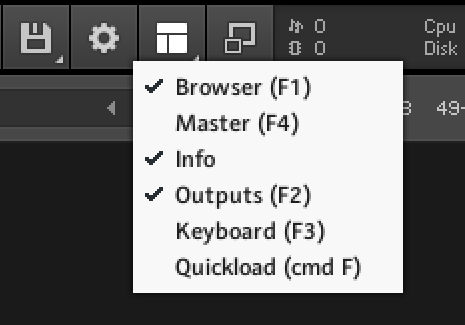The Main Control Panel
Monitor KONTAKT PLAYER's resource usage, access files and preferences, and change how the KONTAKT window is displayed in the Main Control Panel.
The Main Control Panel is the topmost row of elements in the KONTAKT window. Here you can select which parts of the user interface will be displayed, access various global menus, open the Options dialog, and view statistics about KONTAKT PLAYER's overall resource usage.
The Main Control Panel contains the following key features:
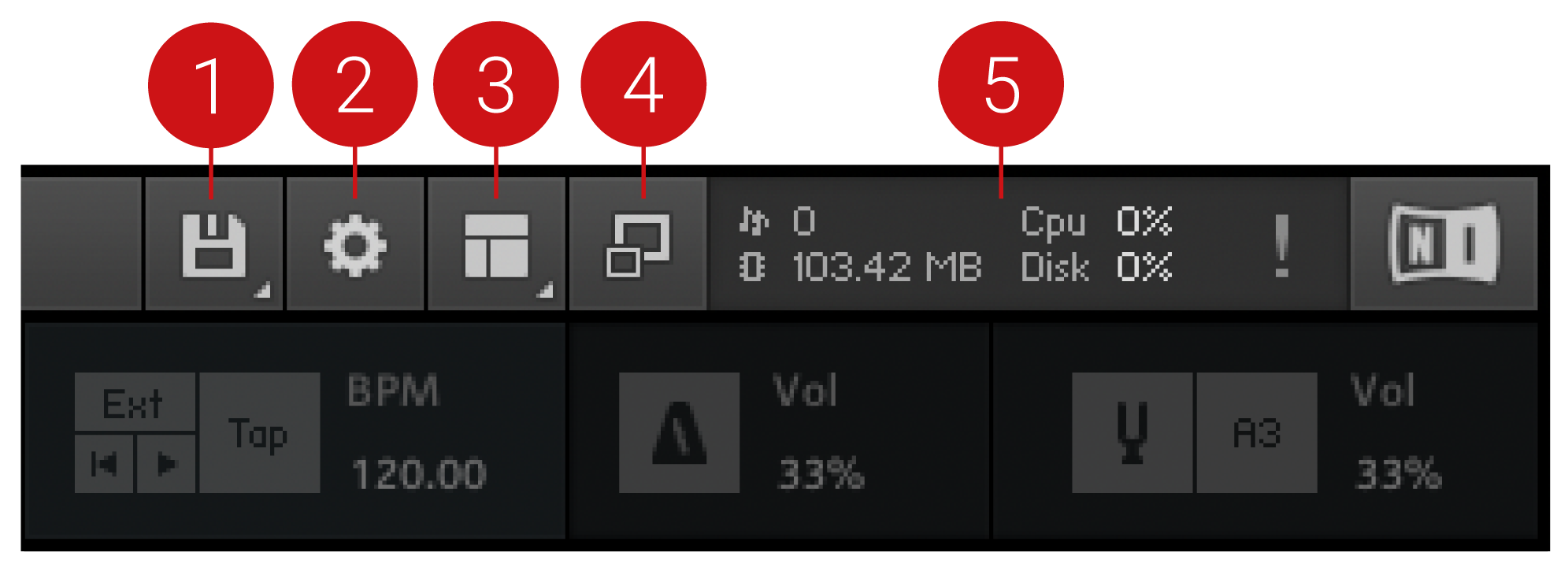 |
Files Menu: Opens the Files menu, which provides options that relate to saving, loading, and creating new instruments and banks. For more information, refer to Files Menu.
Options Menu: Opens the Options dialog, where various settings for the behavior of the synth engine are determined. For more information, refer to Options Dialog.
Workspace Menu: Determines if key elements of the interface will be displayed. This menu allows you to customize the KONTAKT PLAYER workspace to display the tools that you need. For more information, refer to Workspace Menu.
Minimize View: Reduces your KONTAKT PLAYER window to the header of the selected Instrument, and its Performance View (if available). This helps to save screen space and set focus on one Instrument. For more information, refer to Minimize View.
System Performance Meters: Displays a number of system meters that are continuously updated during operation. For more information, refer to System Performance Meters.
Minimize View
Clicking on the rightmost button in the Main Control Panel will reduce your KONTAKT PLAYER window to the header of the currently selected Instrument and, if available, its Performance View. This is a convenient way to save screen space when the full window is not needed.
To collapse the KONTAKT PLAYER window:
Click the Minimized View button in the Main Control Panel.

The KONTAKT window is minimized and displays only the selected Instrument.
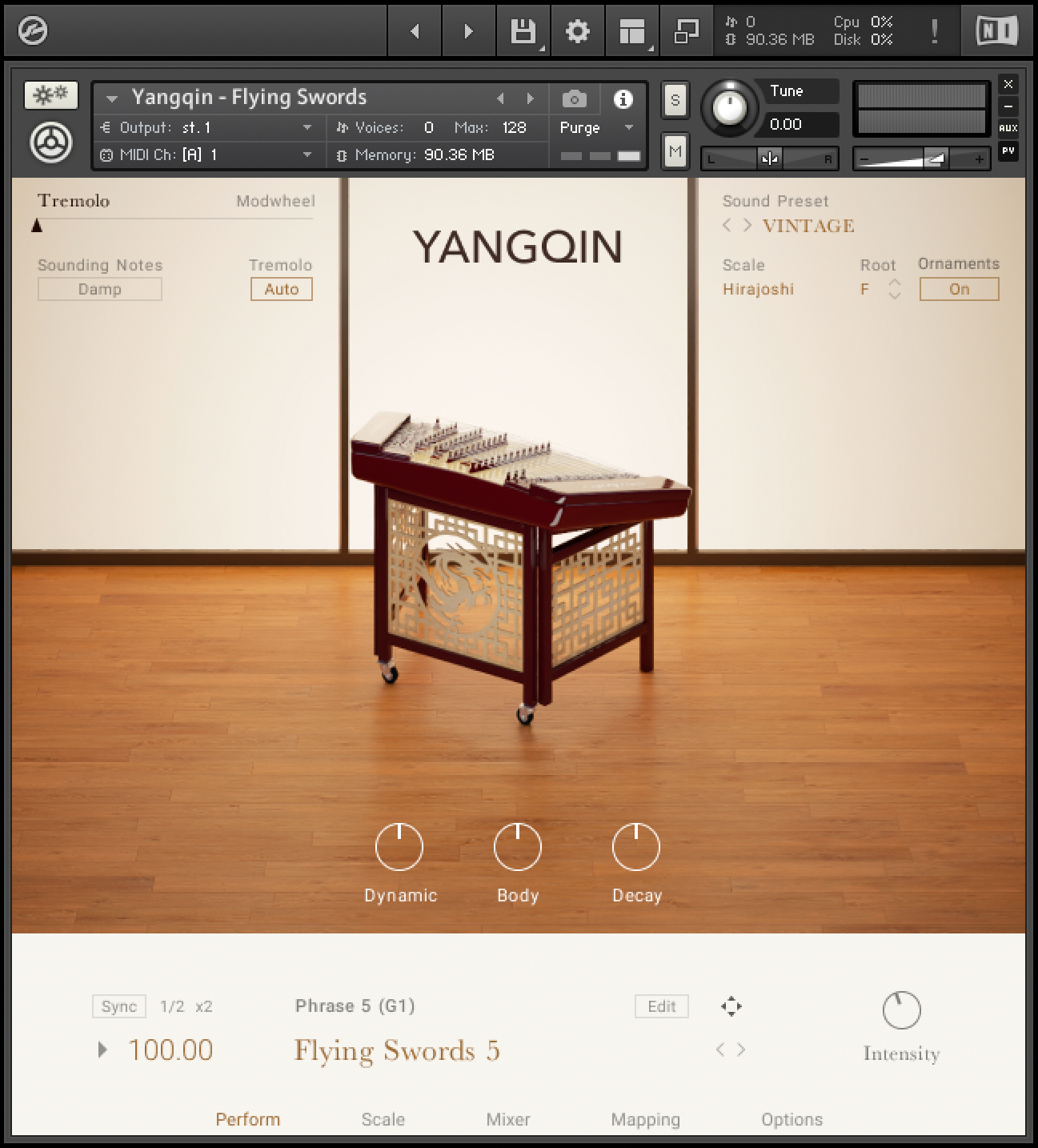
System Performance Meters
In the upper right section of the Main Control Panel, a number of system meters are being continually updated during operation.

Voice count, memory, CPU, and disk meters
The value next to the notes icon indicates the total number of voices that are currently being played (this is also known as the Voice Count).
The values to the right show the current CPU and disk load as percentage values.
The exclamation point (!) is the Restart button and can be used if KONTAKT PLAYER is suffering from hanging voices (i.e. stuck notes) or persistent CPU overloads. Clicking this button will re-initialize KONTAKT PLAYER ’s audio engine, including all the instruments that are currently loaded. Essentially this button is a soft reset, returning all values to their starting positions, but without closing and reloading everything.
Options Dialog
The Options dialog is where you can configure KONTAKT’s global program preferences, such as interface behavior, audio engine parameters, and MIDI options. Preferences are divided into several categories, which you can access via the tabs on the left side.
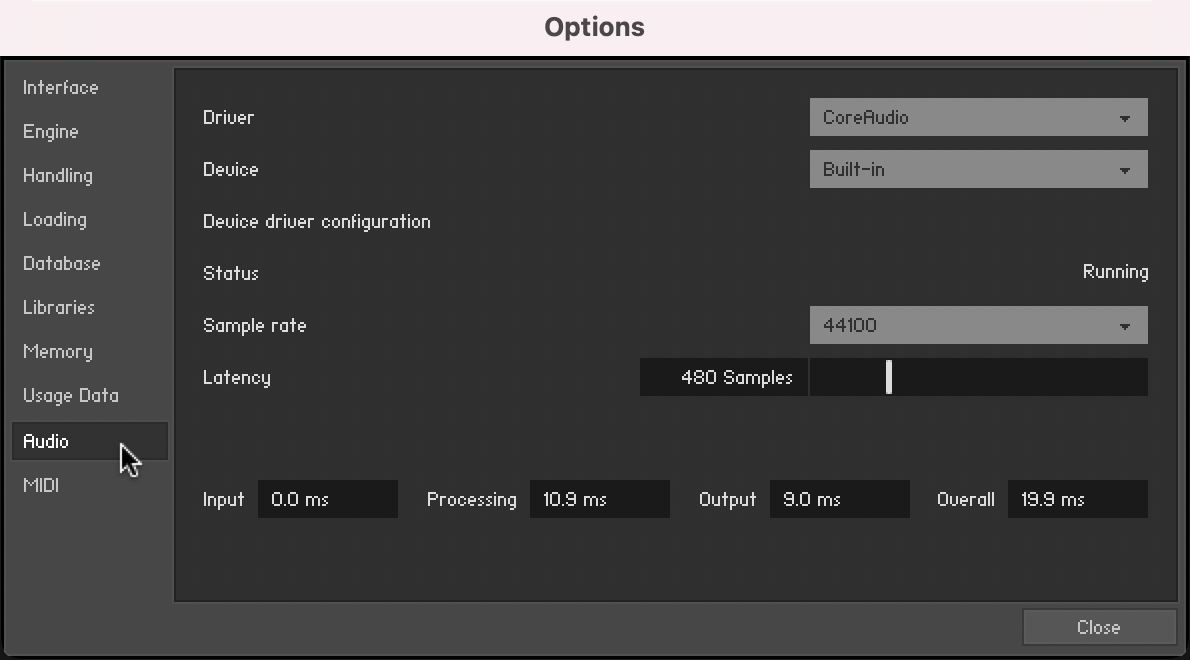 |
Interface Tab
The Interface tab contains options that change the look and behavior of KONTAKT PLAYER’s user interface.
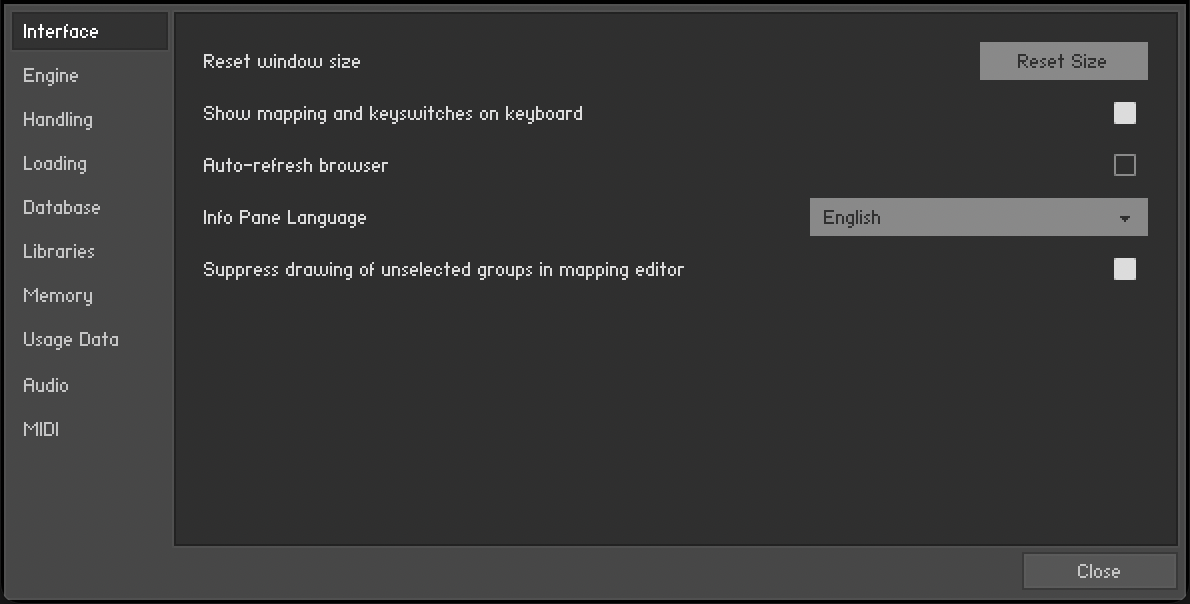 |
Reset Size: If KONTAKT PLAYER’s interface becomes too large and you can no longer access the resizing handle to the bottom right of the window, you can use this button to reset KONTAKT PLAYER’s window size.
Show mapping and keyswitches on keyboard: If activated, KONTAKT PLAYER’s virtual On-Screen Keyboard will highlight keys that trigger zones or keyswitches in your currently selected Instrument with different colors. By default, keys that trigger zones are colored blue and those that trigger keyswitches are colored red, however some libraries may deviate from this convention.
Auto-refresh browser: When activated, the Browser will periodically check your file system for changes and pick them up by itself, without requiring you to refresh it manually.
Info Pane Language: Select a language from the drop-down list. If you select Automatic, KONTAKT will use your operating system’s language settings, unless it is unsupported, in which case KONTAKT will use English.
Suppress drawing of unselected groups in mapping editor: This feature is not available in KONTAKT PLAYER.
Engine Tab
The Engine tab contains options relating to the behavior of KONTAKT PLAYER's engine.
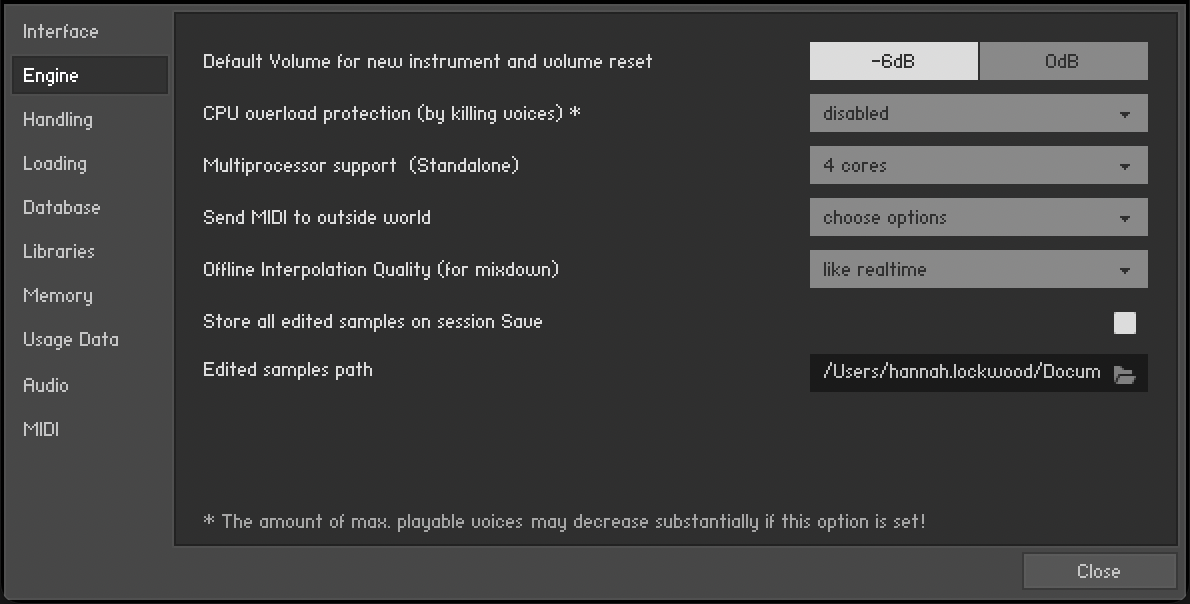 |
Default Volume for new instrument and volume reset: This value will be used as a default output volume for new and imported Instruments. Also, it’s the value to which the output volume slider will snap when you [Ctrl]/[Cmd] + click it.
CPU overload protection: High voice counts can make the audio engine overload your CPU during operation; in such cases, the engine can choke and be rendered unusable until you restart it manually via the Restart Engine button in the Engine sub-tab of the Expert tab in the Browser. This scenario can be avoided with the overload protection mechanism, which allows KONTAKT to kill voices when the CPU load gets critical. The Relaxed, Medium, and Strict settings affect how cautious KONTAKT will be about this. Relaxed will not start killing voices until the CPU is very close to overloading, and thus will give you the highest voice count while still providing some protection against overloading; if the CPU load is still too high, try one of the stricter settings.
Multiprocessor support: KONTAKT can make use of multiple CPUs or multi-core processors. To switch multi-processor support on and off, and to set the number of processors/cores you want to use for KONTAKT, select the corresponding entry from the Multiprocessor support menu.
Send MIDI to outside world: This drop-down menu allows you to choose which classes of MIDI events will be sent to KONTAKT PLAYER’s MIDI output port. Click a menu entry to toggle between on (indicated with a small diamond next to the entry) and off state. The available event classes are:
GUI keyboard: MIDI events that are generated when you click on KONTAKT PLAYER’s virtual On-Screen Keyboard.
script generated CC’s: MIDI controller events that originate from running Scripts.
script generated notes: Note-on and note-off events that originate from running Scripts.
incoming CC’s: This will mirror incoming MIDI controller events at the MIDI output.
incoming notes: Mirrors incoming MIDI note events at the MIDI output.
Offline Interpolation Quality: This option allows you to specify an interpolation quality setting for offline bouncing and freezing that’s different from the one specified in the Source Modules of your Instruments. For instance, you might want to keep your Source Modules set to standard in order to save CPU resources during arrangement, but switch to perfect for bounces to get the best possible quality during mixdown. The default setting is like realtime, which will use each Source Module’s HQI setting during offline operation.
Handling Tab
The Handling tab contains options that relate to the way KONTAKT PLAYER handles external keyboards, MIDI, and Undo commands.
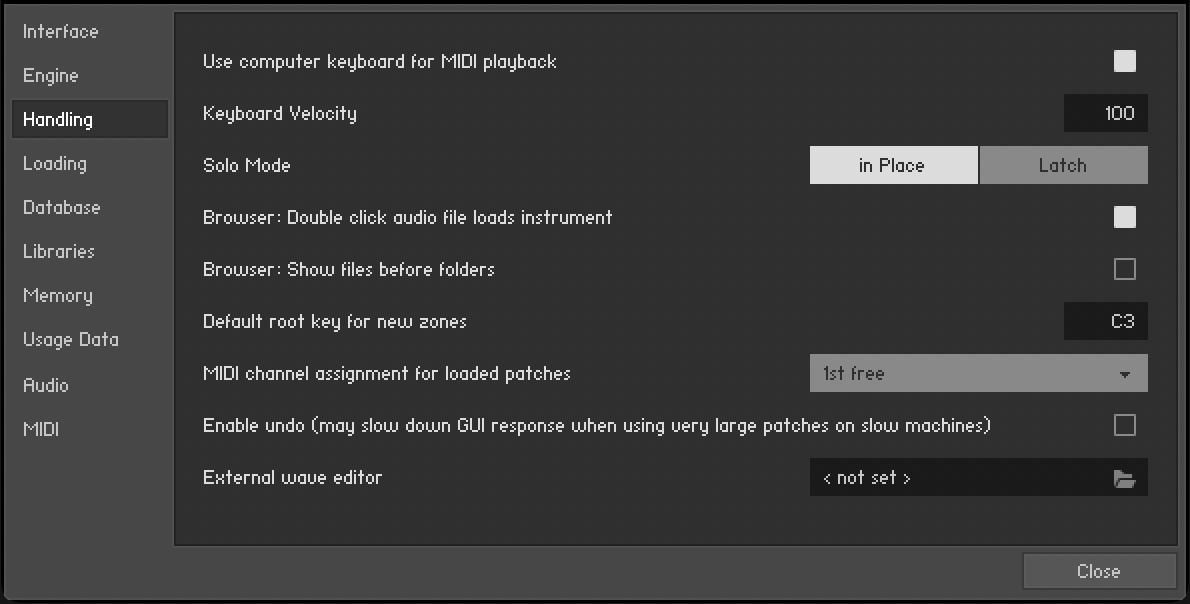 |
Use computer keyboard for MIDI playback: Allows you to use your computer keyboard to trigger MIDI notes for the currently selected Instrument. When activated, the QWERTZ/QWERTY row of letters will play the middle octave.
Keyboard Velocity: Adjusts the velocity of notes that are triggered via your computer keyboard.
Solo Mode: Determines what KONTAKT will do when you attempt to activate the Solo button on more than one Instrument. In Place will only allow one solo Instrument at any time, so any other one will be muted; Latch will let you switch more than one Instrument into solo mode.
Browser: Double-click loads instrument: Enables Instruments to be added into the Rack by double-clicking on their names in the Browse.
Browser: Show files before folders: Determines the order in which files and folders will be listed in the lower pane of the Browser.
Default root-key for new zones: Specifies the root key for new Zones, if they are created from Samples with no embedded pitch information. The Zones will be generated with the root key specified here.
MIDI channel assignment for loaded patches: Opens a drop-down menu that allows you to switch between two different modes that determine the way in which KONTAKT PLAYER will assign MIDI channels to newly added Instruments:
Assign 1st Free is the default setting and will assign the first available MIDI channel.
Assign to Omni is the standard behavior of KONTAKT 1 and will always assign loaded Instruments to Omni, thus making them respond to all input ports.
Keep Channels from K1.x Patches is an additional toggle option that allows you to specify whether KONTAKT should use the MIDI channel embedded in KONTAKT 1 patches. Later versions do not save MIDI assignments in Instrument files, only in Multi files.
Enable undo: Enables the ability to undo actions, when the checkbox is selected. However, this can be quite resource intensive, especially with larger instruments, so by default this setting is unselected.
External wave editor: This featureis not available in KONTAKT PLAYER. This setting allows you to specify your own preferred sample editor. When you click the Ext. Editor button in the Wave Editor, KONTAKT will start the specified editor with the current sample, and automatically pick up the changes when you save the Sample within that editor.
Usage Data
KONTAKT PLAYER collects data regarding your usage of the software in order to better inform future updates. Sending this data to Native Instruments will help make future versions of KONTAKT better, but the choice of whether or not you want to share this information with Native Instruments is yours.
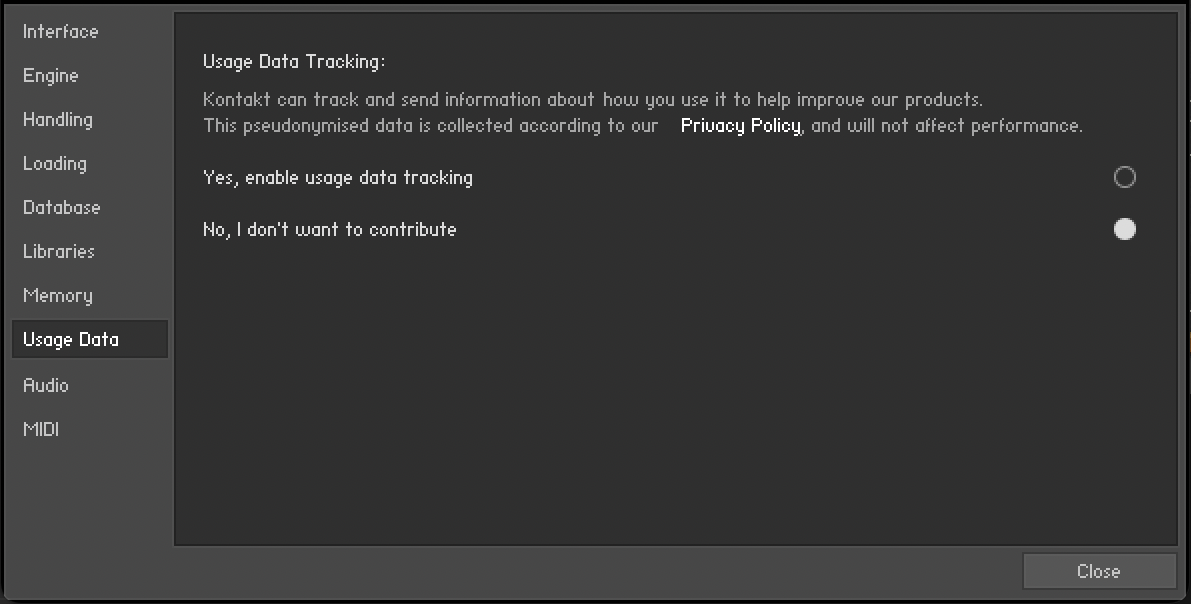 |
Yes, enable usage data tracking: Selects the option to track and send usage data.
No, I don’t want to contribute: Selects the option to turn off data tracking.
Notice
Refer to our Privacy Policy for more information on Usage Data Tracking.
Loading Tab
The Loading tab contains options related to loading samples and KONTAKT files.
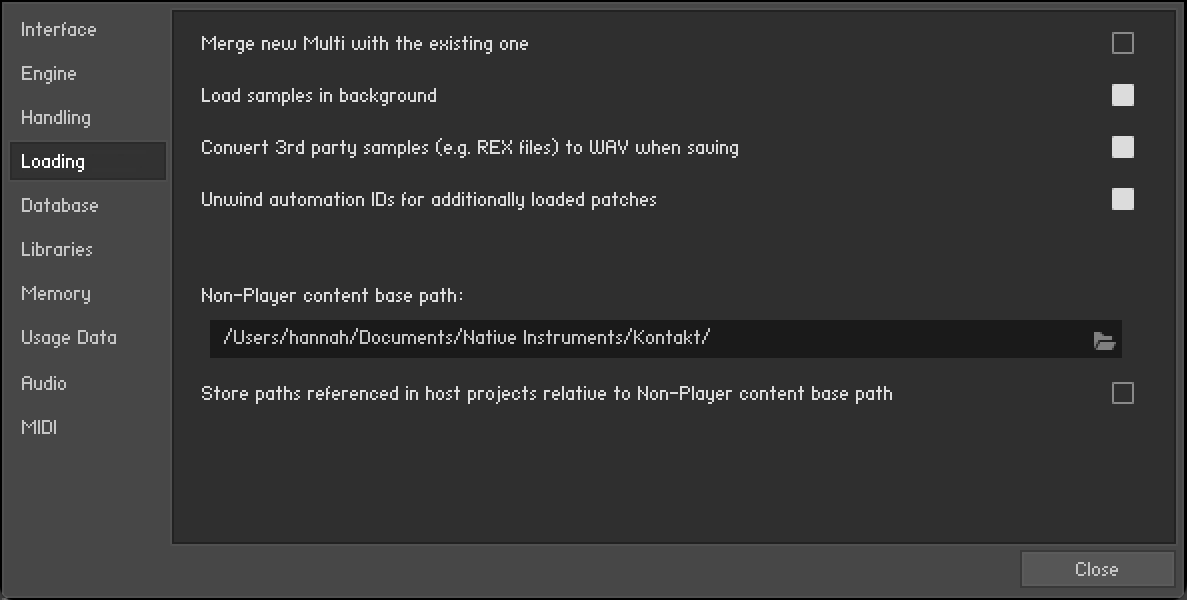 |
Merge new Multi with the existing one: Enables a new Multi to be merged with the current Multi when loaded. If unselected, the current Multi will be discarded when a new Multi is loaded. KONTAKT will not make a check and the current Multi will be replaced instantly.
Load samples in background: Enables KONTAKT to load instruments created in KONTAKT 4.1 or later in the background. This feature is useful for instruments that use a large amount of samples and take a long time to load. With background loading active, KONTAKT will display the instrument’s interface and become playable as soon as possible. Certain keys may not sound immediately if the samples have yet to be loaded into memory.
Convert 3rd party samples to WAV when saving: Enables KONTAKT to save REX Samples used by third-party Instruments in WAV format. When unselected they will be saved in their native format.
Unwind automation IDs for additionally loaded patches: Enables KONTAKT to re-assign automation IDs of newly loaded Instruments if there is already an Instrument in your Multi that uses the same IDs. As an example, if would like to add an Instrument twice to your Multi, which uses automation IDs 0 through 9; if this option is activated, KONTAKT will change the assigned IDs of the second Instrument to 10-19 on load, provided that these IDs have not been used by other Instruments in your Multi yet.
Non-Player content base path: Allows you to specify a base path for your Non-Player content. The option to store referenced paths relative to the base path is provided in the checkbox below. An option to use the path on Save is available and deactivated by default.
Store paths referenced in host projects relative to Non-Player content base path: Determines if referenced paths are stored relative to the base path, or as subpaths. When selected, this option minimizes the occurrence of missing content when using KONTAKT as a plug-in in a host DAW. When a host project is saved, Non-Player content will be able to resolve without the Missing Content dialog, if the libraries are located on the computer’s path as defined in the base path field.
Database Tab
The Database tab contains settings that affect the operation of KONTAKT PLAYER’s Database.
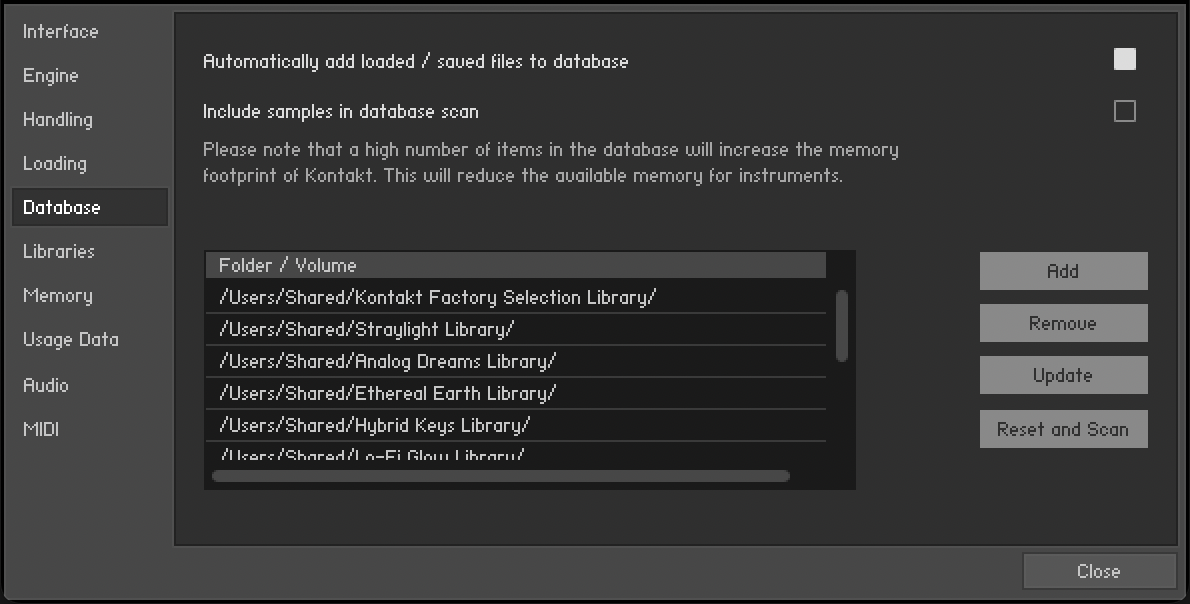 |
Automatically add loaded / saved files to database: When activated, KONTAKT will automatically add any files that you access to the Database if they’re not already included. This helps keeping your Database up to date without the need for manual rebuilds.
Include samples in database scan: If activated, KONTAKT will include information about individual Samples (i.e. audio files) in the Database when scanning your file system for objects. This can be useful when you’re frequently creating and editing your own Instruments; otherwise, it’s not advisable to enable this option, as it can massively increase the size your Database.
Database Location List: Here you can specify locations that should be covered by the Database, such as the directory or partition that contains your sample libraries.
You can add locations to this list by clicking on the Add button and selecting a new location in the selection dialog that appears
Selecting a list entry and clicking on Remove will delete it from the list.
Clicking on the Update button will pick up any changes while preserving all user settings that you’ve made in the Database (such as ratings or color assignments) at the cost of increased disk space consumption.
The Reset and Scan button will erase the entire Database and rebuild it from scratch; all user settings will be lost in this case.
Libraries Tab
The Libraries dialog allows you to define which of your libraries appear in the Libraries tab of the Browser. For more information, refer to The Browser.
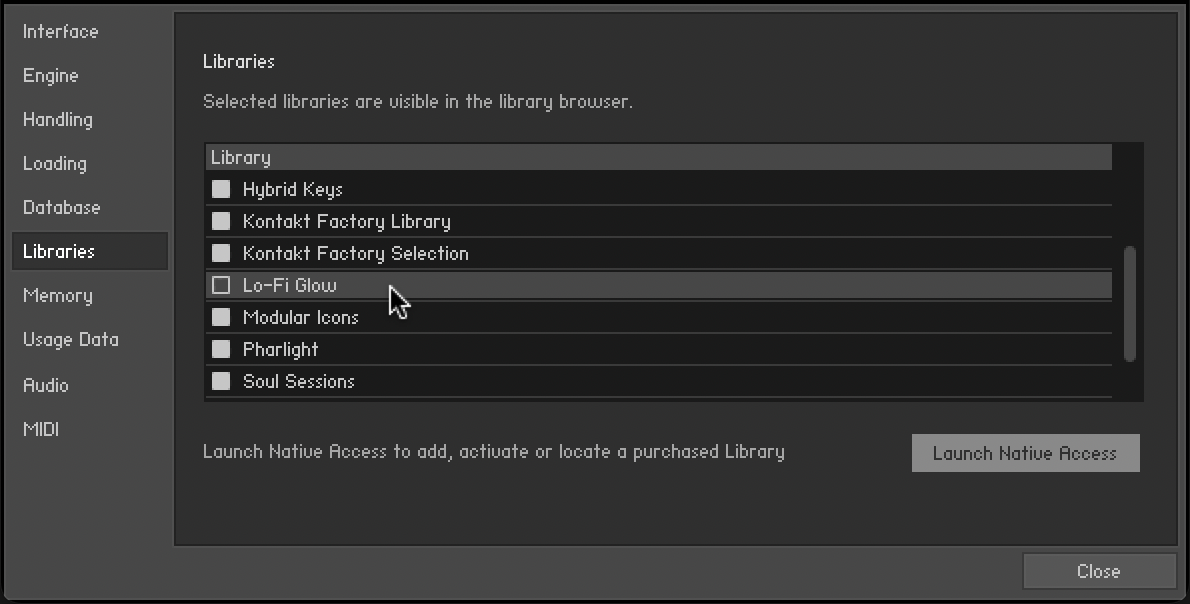 |
Hide Library: Uncheck the entry in the list to hide a library from the Libraries tab of the Browser without uninstalling it from your computer,
Show Library: Check an entry in the list to show a library in the Libraries tab of the Browser.
Tip
You can also open NATIVE ACCESS from the Libraries tab by clicking on the Launch Native Access button. For more information, visit Native Access.
Memory Tab
On the Memory tab, you can optimize KONTAKT PLAYER’s memory usage settings for your specific computer configuration.
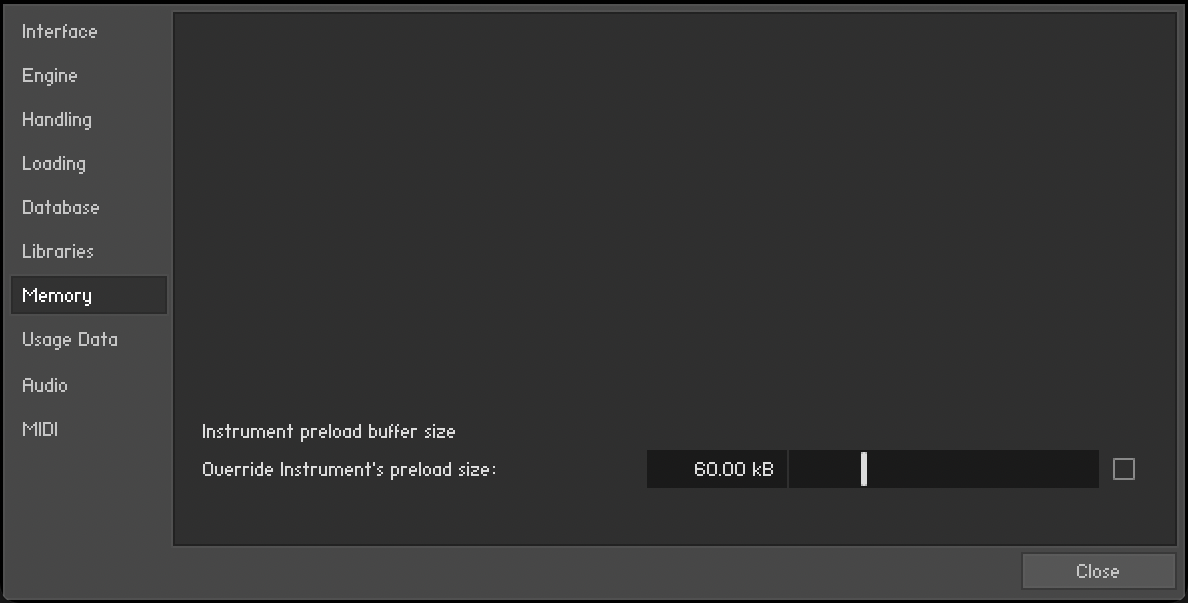 |
Override Instrument’s preload size: If activated, KONTAKT will ignore the preload buffer size that’s embedded in Instrument files since KONTAKT 2, and use the specified buffer size instead. We recommend leaving the preload buffer size on default value. Memory improvements might be possible by moving the slider to the lowest setting possible without experiencing playback errors.
KONTAKT Memory Server Options (Mac OS X only)
Mac OS X cannot address more than 4 GB of RAM (up to 3.5 GB supported) per application.
Notice
Using KMS is only recommended when working with very large numbers of samples which require more physical memory than one KONTAKT instance can access. Do not enable KONTAKT Memory Server if it is not absolutely necessary.
In order to use KMS on your computer, Mac OS X needs to be installed, and at least 4 GB of physical RAM must be available. Using KMS also requires administrator privileges, so make sure you are logged in as an administrator. KONTAKT will detect the Mac OS X version and the amount of RAM present on your computer automatically. Subsequently, it will display an option to enable advanced memory access.
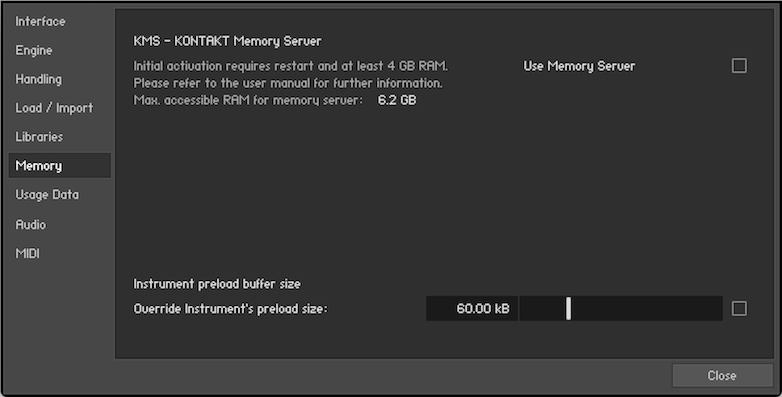 |
The Memory tab on OS X
After activating KMS you need to restart KONTAKT for the changes to take effect.
KONTAKT will automatically set the size of accessible RAM to a value suitable for most cases. You can find the amount of determined accessible RAM in the KMS Options dialog.
KONTAKT Memory Server is a separate application running in background. KONTAKT no longer loads samples itself as long as the KMS option is activated. All running KONTAKT instances share the KONTAKT Memory Server and can access the samples loaded. The KONTAKT Memory Server will boot automatically as soon as you start a KONTAKT instance.
The KMS utility appears in the Mac OS X system bar, so you can monitor the amount of RAM used by the server process. CPU and RAM requirements of KMS utility itself are negligible. Note that there is no option to shut down the KMS utility in Manual mode.
Memory Server Modes
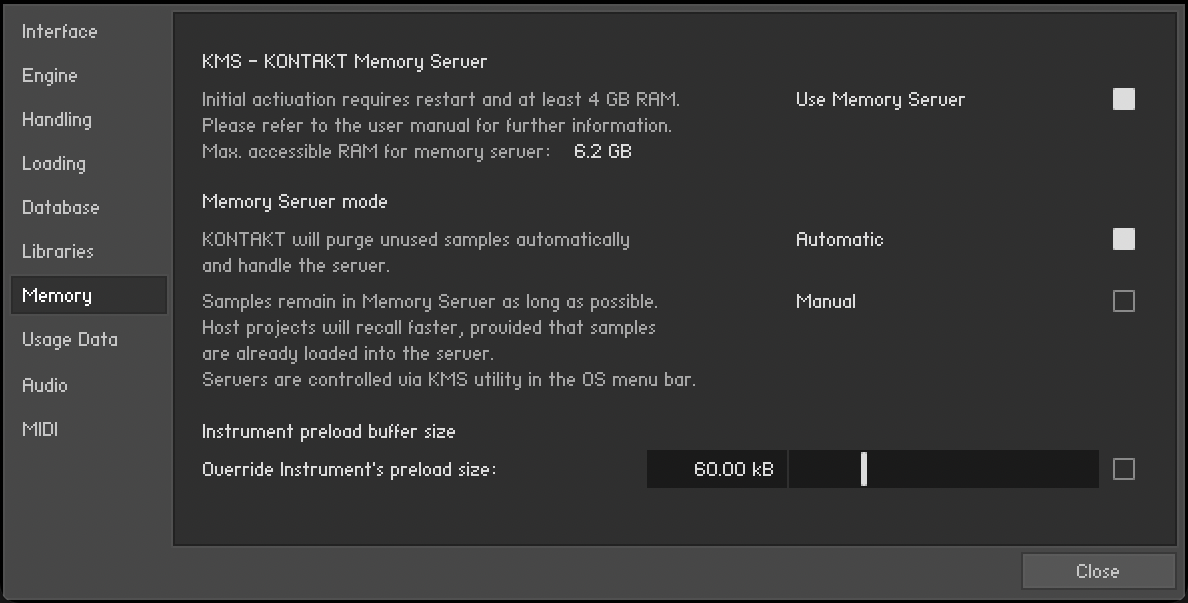 |
The Memory tab with Memory Server mode options
Automatic: In Automatic mode the KMS will keep all samples currently used by KONTAKT instances stored. If an Instrument is removed from KONTAKT’s rack, samples that are no longer needed will be also removed from the Memory Server’s sample pool. The KMS will automatically shut down when all KONTAKT instances are closed.
Manual: In Manual mode the KONTAKT Memory Server does not remove samples from the server when an instrument is removed from KONTAKT’s rack or when all KONTAKT instances are closed. All samples stay in the memory as long as it is running. This can be helpful, e.g. when re-opening a project in your host sequencer which is using KONTAKT as plug-in and when working with extensive templates of numerous instruments. Loading times are significantly shorter, since the samples are already stored in RAM and do not need to be loaded again.
Managing the KONTAKT Memory Server
The KONTAKT Memory Server is managed via the KMS utility, which allows you to manually purge unused samples if you want to free memory. If you are running out of memory when loading additional Instruments, the server will automatically start to purge samples that are not referenced by any loaded Instrument.
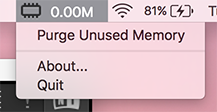 |
The KMS Utility in the Mac OS X system menu bar
